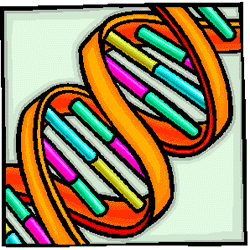The
program I wrote to decipher the raw NCBI HomoloGene data file
and,
the raw NCBI data file (warning: this is a *large* file)
and,
the genes I am using
1 human gene had 20 nonhuman homologs (the winner: accession
NM_002803.2: PSMC2 proteasome (prosome, macropain) 26S subunit, ATPase, 2)
5 human genes had at least 19 nonhuman homologs
6 human genes had at least 18 nonhuman homologs
8 human genes had at least 17 nonhuman homologs
8 human genes had at least 8 nonhuman homologs
and so, the conclusion of this experiment is...
(as viewed in
treeview)

not terribly surprising! that's good! :)
the mouse and the rat are closely related.
the cow and the pig are close, and the human is close to both of them
the trout and the zebrafish (danio) are close, and the frog is close to both of them. makes sense.
the flower is off by itself, ok. very different from everything else. (being the only *plant* in the study)
the only mild surprise is that the fly and c.elegans are close?? well.. hmm. maybe attribute that to emergent consensus-building?
as neither the
neighbor-joined tree nor the original
quartet-puzzled tree have that mildly peculiar quality, it seems reasonable.
ClustalW
Phylip
MAVID
About Mavid Vista
ATV (Forester)
TreeTop
NCBI HomoloGene
bayes aligner
google phylogenetic fasta
MEGA (Molecular Evolutionary Genetics Analysis
The Tree Of Life Web Project (tolweb.org)
The Sanger Institute
European Bioinformatics Institute
Oxford Bioinformatics Centre
NBCI
Homologous Vertebrate Genes Database (HOVERGEN)
Duret, L., Mouchiroud, D. and Gouy, M. (1994) HOVERGEN, a database of homologous vertebrate genes. Nucleic Acids Res. 22, 2360-2365.
Galtier, N., Gouy, M. and Gautier, C. (1996) SeaView and Phylo_win, two graphic tools for sequence alignment and molecular phylogeny. Comput. Applic. Biosci., 12, 543-548.
Bray N, Dubchak I,
Pachter L:
AVID: A Global Alignment Program
Genome Research 2003 13: 97-102 (
supplementary website).
Bray N,
Pachter L: Maximum likelihood ancestral alignment of multiple large genomic regions, submitted.
Mayor C., Brudno M., Schwartz J. R., Poliakov A., Rubin E. M., Frazer K. A., Pachter L. S. and Dubchak I. (2000)
VISTA: Visualizing Global DNA Sequence Alignments of Arbitrary Length.
Bioinformatics, 16: 1046-1047.
Felsenstein, J. 1993. PHYLIP (Phylogeny Inference Package) version 3.5c. Distributed by the author. Department of Genetics, University of Washington, Seattle.
Felsenstein, J. 1989. PHYLIP -- Phylogeny Inference Package (Version 3.2). Cladistics 5: 164-166.
Strimmer, K., and A. von Haeseler. 1996. Quartet puzzling:A quartet maximum likelihood method for reconstructing tree topologies. Mol. Biol. Evol. 13: 964-969
any questions, comments, or suggestions, please email
zo. (zoo at cs dot uchicago dot edu)

